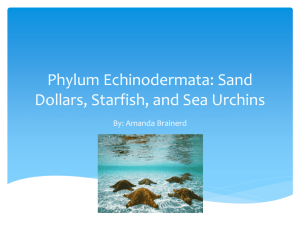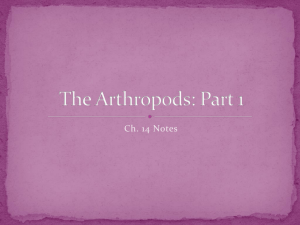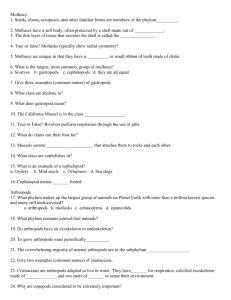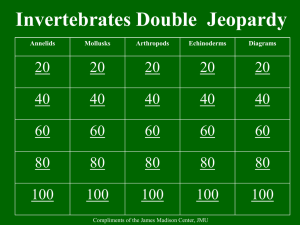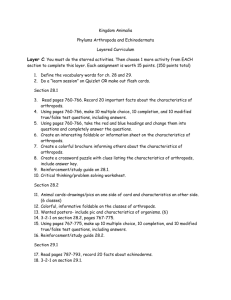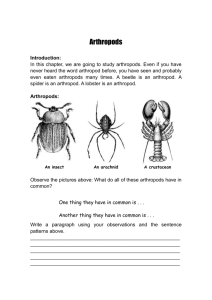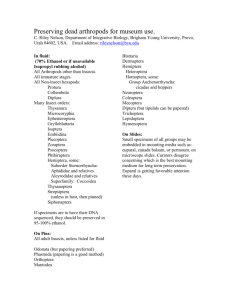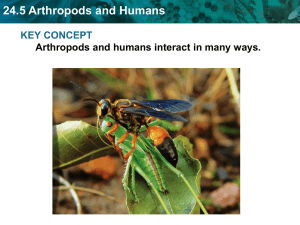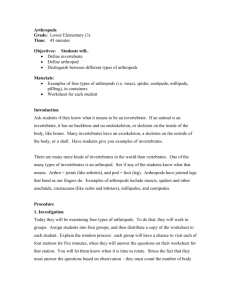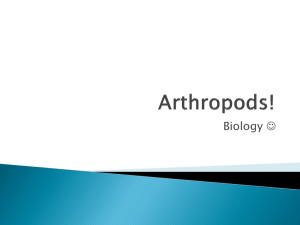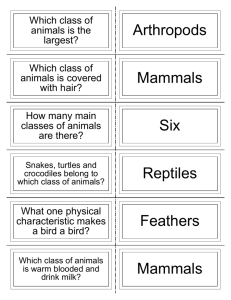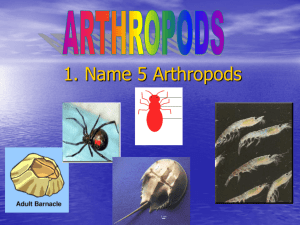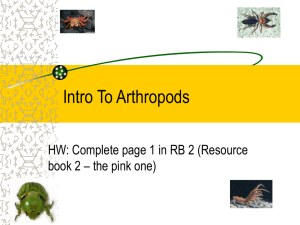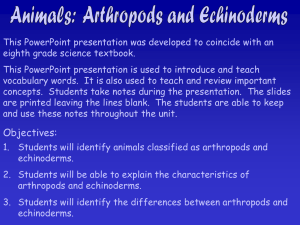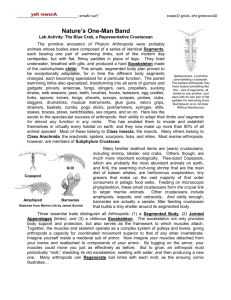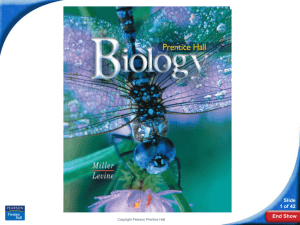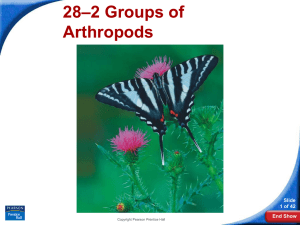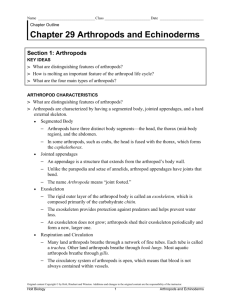arthropoda & echinodermata review worksheet
advertisement
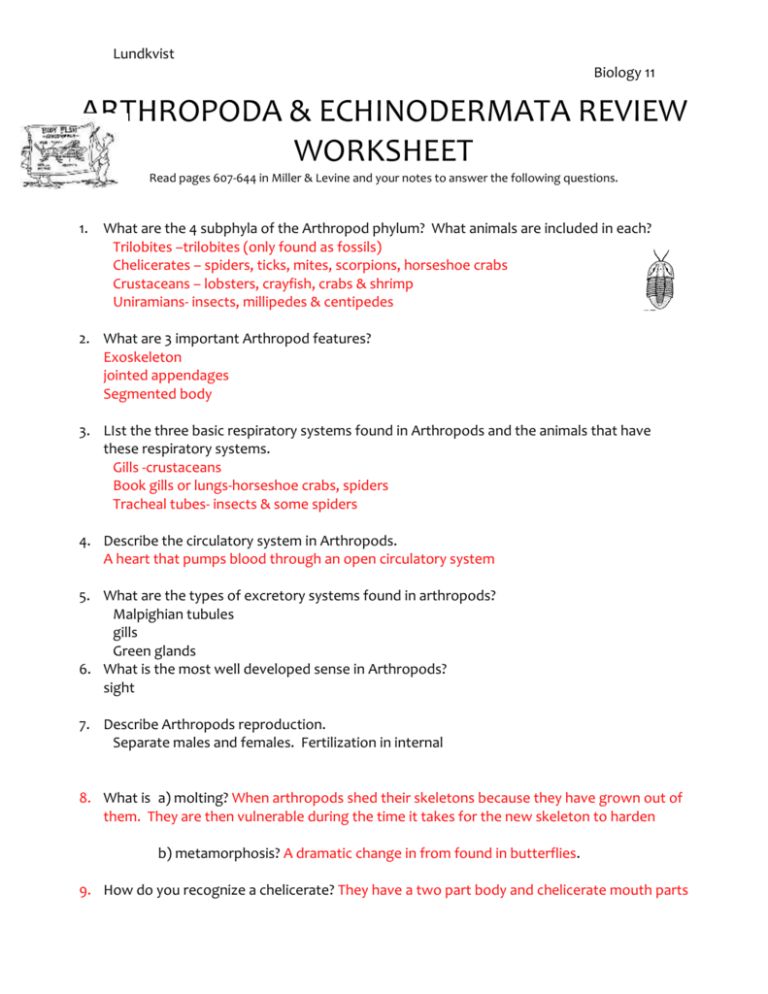
Lundkvist Biology 11 ARTHROPODA & ECHINODERMATA REVIEW WORKSHEET Read pages 607-644 in Miller & Levine and your notes to answer the following questions. 1. What are the 4 subphyla of the Arthropod phylum? What animals are included in each? Trilobites –trilobites (only found as fossils) Chelicerates – spiders, ticks, mites, scorpions, horseshoe crabs Crustaceans – lobsters, crayfish, crabs & shrimp Uniramians- insects, millipedes & centipedes 2. What are 3 important Arthropod features? Exoskeleton jointed appendages Segmented body 3. LIst the three basic respiratory systems found in Arthropods and the animals that have these respiratory systems. Gills -crustaceans Book gills or lungs-horseshoe crabs, spiders Tracheal tubes- insects & some spiders 4. Describe the circulatory system in Arthropods. A heart that pumps blood through an open circulatory system 5. What are the types of excretory systems found in arthropods? Malpighian tubules gills Green glands 6. What is the most well developed sense in Arthropods? sight 7. Describe Arthropods reproduction. Separate males and females. Fertilization in internal 8. What is a) molting? When arthropods shed their skeletons because they have grown out of them. They are then vulnerable during the time it takes for the new skeleton to harden b) metamorphosis? A dramatic change in from found in butterflies. 9. How do you recognize a chelicerate? They have a two part body and chelicerate mouth parts Lundkvist Biology 11 10. What are arachnids and which animals are included in this grouping? Animals with 8 legs. They include spiders, ticks, scorpions & mites 11. How do you recognize a crustacean? They have a hard exoskeleton, two pairs of antennae and mouthparts called mandibles 12. How do you recognize a Uniramian? They have one pair of antennae and their appendages don’t branch. 13. What are the main features of animals belonging to the insects? They have a three part body; head, thorax and abdomen and they have 3 pairs of legs. 14. What are the characteristic features of members of Phylum Echinodermata? Spiny skin Five part radial symmetry Internal skeleton Water vascular system Tube feet 15. What is the water vascular system? A system of tubes that helps the animal move around using its tube feet 16. Describe how a sea urchin moves using its tube feet. It has flexible spines that help it move along with its tube feet. I’m telling you, starfish are dangerous. 17. Describe how a sea star eats a clam. It pries the bivalve shell open, and inserts its stomach into the shell. The stomach releases enzymes that digest the bivalve alive. The stomach then absorbs the nutrients and the sea star pulls it back into its body. 18. Where does respiration take place in Echinoderms? Skin gills – special thin tissues for gas exchange Tube feet 19. What do Echinoderms have instead of a brain? A nerve ring 20. What fascinating reproductive ability do starfish have? They can regenerate body parts. 21. How did bivalve fishermen unknowingly increase the population of starfish they were trying to kill? They caught sea stars and cut them in half. Instead of killing them, they made twice as many. Lundkvist Biology 11 22. Write their class name next to the echinoderms below: a) star fish/brittle stars Asteroidea b) sea urchins/sand dollars Echinoidea c) sea cucumbers Ophiuroidea d) sea lilies/ feather stars Chrinoidea 23. Have you ever eaten sea urchin or sea cucumber? NO!
